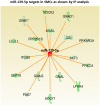Role of differentially expressed microRNA-139-5p in the regulation of phenotypic internal anal sphincter smooth muscle tone
- PMID: 28469189
- PMCID: PMC5431208
- DOI: 10.1038/s41598-017-01550-5
Role of differentially expressed microRNA-139-5p in the regulation of phenotypic internal anal sphincter smooth muscle tone
Abstract
The present study focused on the role of microRNA-139-5p (miRNA-139-5p) in the regulation of basal tone in internal anal sphincter (IAS). Applying genome-wide miRNA microarrays on the phenotypically distinct smooth muscle cells (SMCs) within the rat anorectrum, we identified miRNA-139-5p as differentially expressed RNA repressor with highest expression in the purely phasic smooth muscle of anococcygeus (ASM) vs. the truly tonic smooth muscle of IAS. This pattern of miRNA-139-5p expression, previously shown to target ROCK2, was validated by target prediction using ingenuity pathway (IPA) and by qPCR analyses. Immunoblotting, immunocytochemistry (ICC), and functional assays using IAS tissues and cells subjected to overexpression/knockdown of miRNA-139-5p confirmed the inverse relationship between miRNA-139-5p and ROCK2 expressions/IAS tone. Overexpression of miRNA-139-5p caused a decrease, while knockdown by anti-miRNA-139-5p caused an increase in the IAS tone; these tissue contractile responses were confirmed by single-cell contraction using magnetic twisting cytometry (MTC). These findings suggest miRNA-139-5p is capable of significantly influencing the phenotypic tonicity in smooth muscle via ROCK2: a lack of tone in ASM may be associated with the suppression of ROCK2 by high expression of miRNA-139-5p, whereas basal IAS tone may be associated with the persistence of ROCK2 due to low expression of miRNA-139-5p.
Conflict of interest statement
The authors declare that they have no competing interests.
Figures







Similar articles
-
In vivo magnetofection: a novel approach for targeted topical delivery of nucleic acids for rectoanal motility disorders.Am J Physiol Gastrointest Liver Physiol. 2018 Jan 1;314(1):G109-G118. doi: 10.1152/ajpgi.00233.2017. Epub 2017 Oct 19. Am J Physiol Gastrointest Liver Physiol. 2018. PMID: 29051187 Free PMC article.
-
Aging-associated changes in microRNA expression profile of internal anal sphincter smooth muscle: Role of microRNA-133a.Am J Physiol Gastrointest Liver Physiol. 2016 Nov 1;311(5):G964-G973. doi: 10.1152/ajpgi.00290.2016. Epub 2016 Sep 15. Am J Physiol Gastrointest Liver Physiol. 2016. PMID: 27634012 Free PMC article.
-
Cellular regulation of basal tone in internal anal sphincter smooth muscle by RhoA/ROCK.Am J Physiol Gastrointest Liver Physiol. 2007 Jun;292(6):G1747-56. doi: 10.1152/ajpgi.00438.2006. Epub 2007 Mar 22. Am J Physiol Gastrointest Liver Physiol. 2007. PMID: 17379756
-
Generation of Spontaneous Tone by Gastrointestinal Sphincters.Adv Exp Med Biol. 2019;1124:47-74. doi: 10.1007/978-981-13-5895-1_2. Adv Exp Med Biol. 2019. PMID: 31183822 Review.
-
The internal anal sphincter: regulation of smooth muscle tone and relaxation.Neurogastroenterol Motil. 2005 Jun;17 Suppl 1:50-9. doi: 10.1111/j.1365-2982.2005.00659.x. Neurogastroenterol Motil. 2005. PMID: 15836455 Review.
Cited by
-
Cell Therapy for Anal Sphincter Incontinence: Where Do We Stand?Cells. 2021 Aug 13;10(8):2086. doi: 10.3390/cells10082086. Cells. 2021. PMID: 34440855 Free PMC article. Review.
-
The Prevalence of Enteropathy Symptoms from the Lower Gastrointestinal Tract and the Evaluation of Anorectal Function in Diabetes Mellitus Patients.J Clin Med. 2021 Jan 22;10(3):415. doi: 10.3390/jcm10030415. J Clin Med. 2021. PMID: 33499216 Free PMC article.
-
In vivo magnetofection: a novel approach for targeted topical delivery of nucleic acids for rectoanal motility disorders.Am J Physiol Gastrointest Liver Physiol. 2018 Jan 1;314(1):G109-G118. doi: 10.1152/ajpgi.00233.2017. Epub 2017 Oct 19. Am J Physiol Gastrointest Liver Physiol. 2018. PMID: 29051187 Free PMC article.
-
BDNF augments rat internal anal sphincter smooth muscle tone via RhoA/ROCK signaling and nonadrenergic noncholinergic relaxation via increased NO release.Am J Physiol Gastrointest Liver Physiol. 2020 Jan 1;318(1):G23-G33. doi: 10.1152/ajpgi.00247.2019. Epub 2019 Nov 4. Am J Physiol Gastrointest Liver Physiol. 2020. PMID: 31682160 Free PMC article.
-
MiR-152 Regulates Apoptosis and Triglyceride Production in MECs via Targeting ACAA2 and HSD17B12 Genes.Sci Rep. 2018 Jan 11;8(1):417. doi: 10.1038/s41598-017-18804-x. Sci Rep. 2018. PMID: 29323178 Free PMC article.
References
Publication types
MeSH terms
Substances
Grants and funding
LinkOut - more resources
Full Text Sources
Other Literature Sources
Molecular Biology Databases

